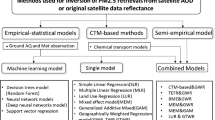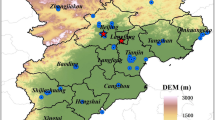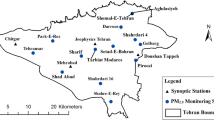Abstract
PM2.5, a dangerous air pollutant, mapping on a city level scale, plays a crucial role in the development of sustainable policies toward balanced ecology and a pollution-free society. Recently, multispectral and hyperspectral satellite imagery promise a high capability toward detecting the places with soaring atmospheric pollution and aerosol information. The multispectral imagery uses the ambient surface reflectance from the surface of the earth in the visible spectrum bands. LANDSAT-8 satellite provides multispectral observations over the surface of the earth with 30m resolution. We develop various machine learning models for PM2.5 estimation for one of the most highly polluted cities in the world, Delhi, the captial city of India using LANDSAT-8 observations and ground-level PM2.5 data. A feasible multispectral-based PM2.5 estimation model is established in this study, which promises high-resolution PM2.5 mapping from LANDSAT-8 imagery with an acceptable level of accuracy.
Access this chapter
Tax calculation will be finalised at checkout
Purchases are for personal use only
Similar content being viewed by others
References
USGS, Department of the Interior U.S. Geological Survey, Landsat 8 (L8) Data Users Handbook (2019, November). Available online at https://www.usgs.gov/media/files/landsat-8-data-users-handbook. https://doi.org/10.5066/P9OGBGM6
Alvarez-Mendoza, C.I., Teodoro, A.C., Torres, N., Vivanco, V.: Assessment of remote sensing data to model PM10 estimation in cities with a low number of air quality stations: a case of study in Quito, Ecuador. Environments 6(7), 85 (2019)
Mishra, R.K., Agarwal, A., Shukla, A.: Predicting ground-level PM2.5 concentration over Delhi using Landsat 8 satellite data. Int. J. Remote Sens. 42(3), 827–838 (2021)
Chen, Y., Han, W., Chen, S., Tong, L.: Estimating ground-level PM2.5 concentration using Landsat 8 in Chengdu, China. In Remote Sensing of the Atmosphere, Clouds, and Precipitation V (Vol. 9259). SPIE (2014)
Chen, N., Yang, M., Du, W., Huang, M.: PM2.5 estimation and spatial-temporal pattern analysis based on the modified support vector regression model and the 1 km resolution MAIAC AOD in Hubei, China. ISPRS Int. J. Geo-Inf. 10(1), 31 (2021)
Xue, W., et al.: Inferring near-surface PM2.5 concentrations from the VIIRS deep blue aerosol product in China: a spatiotemporally weighted random forest model. Remote Sens. 13(3), 505 (2021)
Rizwan, S.A., Nongkynrih, B., Gupta, S.K.: Air pollution in Delhi: its magnitude and effects on health. Indian J. Community Med. 38(1), 4 (2013)
Liu, Z.-S., Siu, W.-C., Huang, J.-J.: Image super-resolution via weighted random forest. In: 2017 IEEE International Conference on Industrial Technology (ICIT). IEEE (2017)
Bali, V., Kumar, A., Gangwar, S.: Deep learning based wind speed forecasting-a review. In: 2019 9th International Conference on Cloud Computing, Data Science & Engineering (Confluence). IEEE (2019)
Senthil, K.P.: Improved prediction of wind speed using machine learning. EAI Endorsed Trans. Energy Web 6(23) (2019)
Scornet, E. Trees, forests, and impurity-based variable importance. arXiv preprint arXiv:2001.04295 (2020)
Karlson, M., Ostwald, M., Reese, H., Sanou, J., Tankoano, B., Mattsson, E.: Mapping tree canopy cover and aboveground biomass in Sudano-Sahelian woodlands using Landsat 8 and random forest. Remote Sens. 7(8), 10017–10041 (2015)
Topouzelis, K., Psyllos, A.: Oil spill feature selection and classification using decision tree forest on SAR image data. ISPRS J. Photogrammetry Remote Sens. 68, 135–143 (2012)
Mellor, A., Boukir, S., Haywood, A., Jones, S.: Exploring issues of training data imbalance and mislabelling on random forest performance for large area land cover classification using the ensemble margin. ISPRS J. Photogrammetry Remote Sens. 105, 155–168 (2015)
Zhang, Y., et al.: Satellite remote sensing of atmospheric particulate matter mass concentration: advances, challenges, and perspectives. Fundam. Res. 1(3), 240–258 (2021)
Author information
Authors and Affiliations
Corresponding author
Editor information
Editors and Affiliations
Rights and permissions
Copyright information
© 2023 The Author(s), under exclusive license to Springer Nature Singapore Pte Ltd.
About this paper
Cite this paper
Ejurothu, P.S.S., Mandal, S., Thakur, M. (2023). A Machine Learning Approach for PM2.5 Estimation for the Capital City of New Delhi Using Multispectral LANDSAT-8 Satellite Observations. In: Tistarelli, M., Dubey, S.R., Singh, S.K., Jiang, X. (eds) Computer Vision and Machine Intelligence. Lecture Notes in Networks and Systems, vol 586. Springer, Singapore. https://doi.org/10.1007/978-981-19-7867-8_31
Download citation
DOI: https://doi.org/10.1007/978-981-19-7867-8_31
Published:
Publisher Name: Springer, Singapore
Print ISBN: 978-981-19-7866-1
Online ISBN: 978-981-19-7867-8
eBook Packages: Intelligent Technologies and RoboticsIntelligent Technologies and Robotics (R0)




